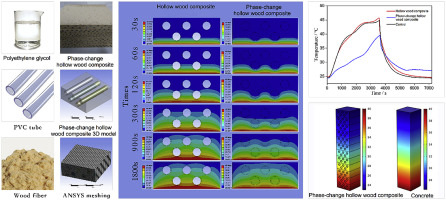Journal of Cleaner Production ( IF 9.7 ) Pub Date : 2020-02-06 , DOI: 10.1016/j.jclepro.2020.120373
Chusheng Qi , Feng Zhang , Jun Mu , Yang Zhang , Zhiming Yu

|
To obtain lightweight wood building materials with good thermal insulation, energy-saving properties, and satisfying mechanical properties, low-density fiberboard and hollow wood composites (HWC) embedded polyvinyl chloride tubes were fabricated by hot-pressing. Polyethylene glycol was used as the phase-change material to fill polyvinyl chloride tubes and obtain phase-change hollow wood composite (PHWC). The physical and mechanical properties of HWC and PHWC were tested, and their thermal properties were analyzed and simulated. The results showed that the thermal conductivities of low-density fiberboard, HWC, and PHWC ranged from 0.06 to 0.07 W/(m·K), indicating they had sufficient physical and mechanical properties to be used as thermal insulation building materials. The combination of series and parallel models accurately predicted the thermal conductivity of HWC and PHWC, whose structures were similar to a series structure. The addition of polyethylene glycol into HWC allowed the PHWC to store latent heat and reduce indoor temperature fluctuations. Heat transfer simulations showed that when used as a non-structural building wall material, the PHWC wall had a better energy efficiency compared with a concrete wall. Thus, PHWC has potential applications as thermal insulation and phase-change building material.
中文翻译:

填充相变材料的空心木复合材料的增强的机械和热性能
为了获得具有良好的隔热,节能性能和令人满意的机械性能的轻质木建筑材料,通过热压制造了低密度纤维板和中空木复合材料(HWC)嵌入式聚氯乙烯管。聚乙二醇用作相变材料填充聚氯乙烯管并获得相变空心木复合材料(PHWC)。测试了HWC和PHWC的物理和机械性能,并对它们的热性能进行了分析和模拟。结果表明,低密度纤维板,HWC和PHWC的导热系数在0.06至0.07 W /(m·K)的范围内,表明它们具有足够的物理和机械性能,可以用作绝热建筑材料。串联模型和并联模型的组合准确地预测了HWC和PHWC的热导率,它们的结构类似于串联结构。在HWC中添加聚乙二醇可使PHWC储存潜热并减少室内温度波动。传热模拟表明,与混凝土墙相比,PHWC墙用作非结构建筑墙材料时具有更高的能源效率。因此,PHWC具有作为隔热材料和相变建筑材料的潜在应用。与混凝土墙相比,PHWC墙的能源效率更高。因此,PHWC具有作为隔热材料和相变建筑材料的潜在应用。与混凝土墙相比,PHWC墙的能源效率更高。因此,PHWC具有作为隔热材料和相变建筑材料的潜在应用。







































 京公网安备 11010802027423号
京公网安备 11010802027423号